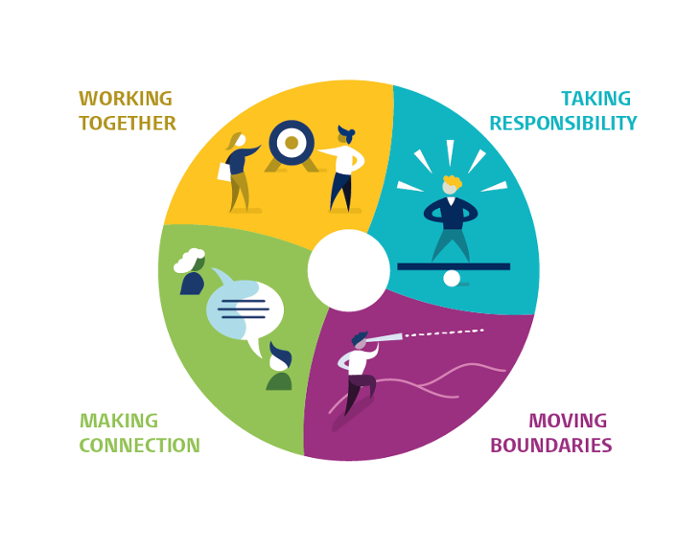Competences
Our leadership model consists of four competences that align with our core values. Each leadership competence expresses two opposing qualities. The goal is not to prioritise one of these qualities over the other, but to find the right balance between them. Effective leadership starts with awareness of your own preferences.
Four leadership competences
Connecting
Head versus Heart
Consciously approaching others in an open, respectful way, recognising, and valuing our differences and acting in the interest of others and of the organisation.
Connecting is about striking a balance between thinking and feeling. On the one hand, you use your intellect to understand things, and on the other hand, you show empathy and understanding. Both are equally important.
Working together
I versus We
Working to achieve a shared objective and taking advantage of a range of different experiences and perspectives to move forward together.
Sometimes you focus on what you or your team needs. Sometimes the situation requires you to focus on the broader environment. This is about balancing your own role with the interests of the whole.
Taking responsibility
Analysis versus Action
Setting clear expectations and objectives for yourself and others, so you can work decisively and with confidence, balance and focus to achieve results.
This is about both thinking and doing. You must analyse the situation carefully, but also not wait too long to take action and manage the situation.
Moving boundaries
Now versus the Future
Learning to look beyond your own limits, adapt to change and contribute to improvement and innovation with a vision for the future.
It is important to understand the current situation well, but also to look ahead. That way you can ensure success in both the short and the long term.

Competence maps and matrix
To make the four leadership competences concrete, we have developed a deck of 54 competence cards. These cards can support you in your personal and team development: you can use them in GROW interviews or problem analyses, or to compliment your team. The cards contain a description of relevant behaviour with clear examples, as well as potential challenges or obstacles you may face.
All the cards have been integrated into a matrix, which works as a useful dashboard, and provides quick insight into:
- Strengths
- Areas for attention
- Opportunities for growth
Where can I get the Leadership card set?
The card sets are available in English or Dutch from your HR department. You can also request a set by sending an e-mail to leiderschap@bb.leidenuniv.nl. Want to know how to use the cards? Download the Self-start Leadership or watch the animation below.
Due to the selected cookie settings, we cannot show this video here.
Watch the video on the original website orUse the Let's Connect toolkit and get inspired about using your leadership skills:
- How do I connect?
- How do I exert influence?
- How do I speak up?
- How do I run effective meetings?
Leadership is closely linked to well-being and social safety, because you can contribute to your own well-being and a pleasant working environment.
Who do you lead?
There are four leadership roles. It starts by leading yourself and expands depending on who you are leading.
-
Yourself
You take control of your own development and performance. -
Others
You work together with others and/or lead a few others formally or informally. -
A team
You are part of a team and/or lead a team or group. -
The organisation
You contribute to the organisation, a faculty or a unit and/or you lead one.


